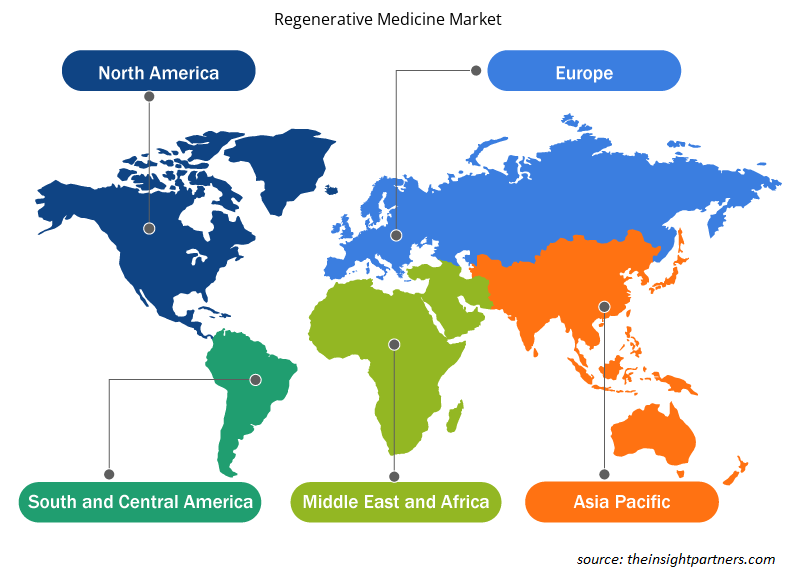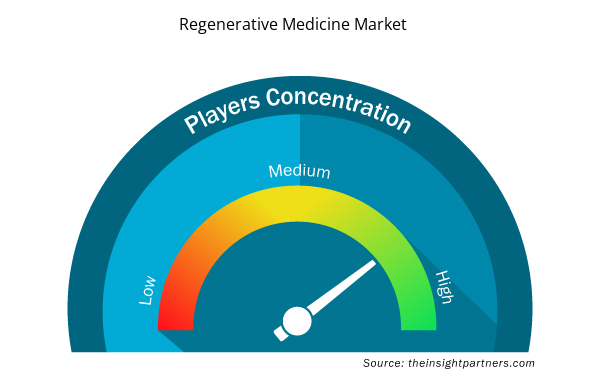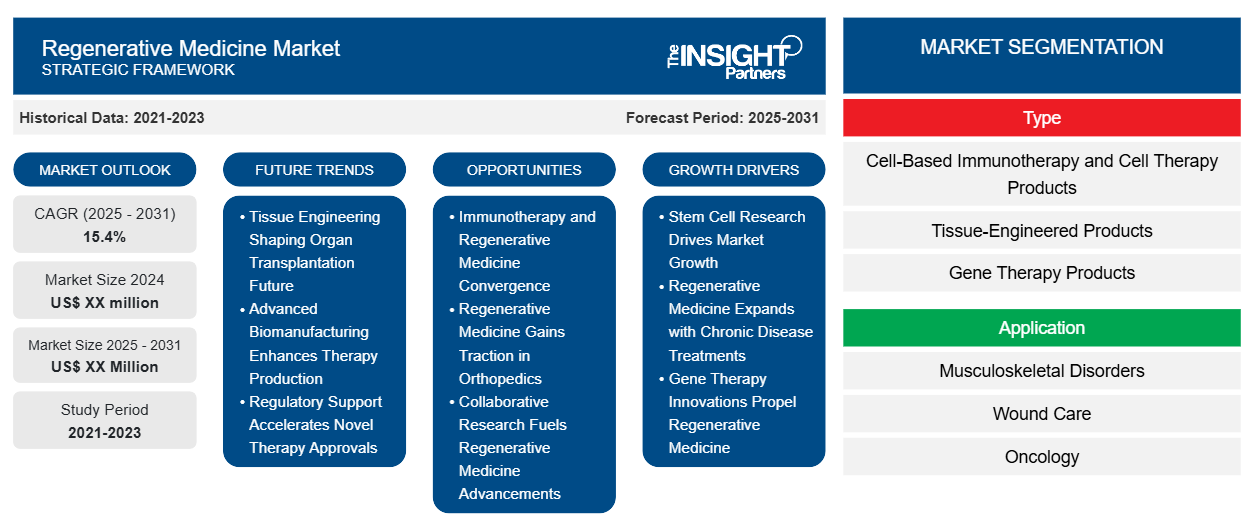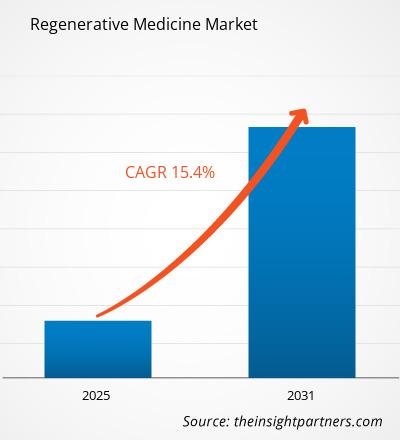Se espera que el mercado de medicina regenerativa registre una CAGR del 15,4 % entre 2023 y 2031, con un tamaño de mercado que se expandirá de US$ XX millones en 2023 a US$ XX millones en 2031.CAGR of 15.4% from 2023 to 2031, with a market size expanding from US$ XX million in 2023 to US$ XX Million by 2031.
El informe de mercado de medicina regenerativa cubre el análisis por tipo (inmunoterapia celular y productos de terapia celular, productos de ingeniería tisular y productos de terapia génica) y aplicación (trastornos musculoesqueléticos, cuidado de heridas, oncología, trastornos oculares y diabetes). El informe de investigación proporciona una descripción general global y regional del mercado.
Propósito del Informe
El informe Regenerative Medicine Market de The Insight Partners tiene como objetivo describir el panorama actual y el crecimiento futuro, los principales factores impulsores, los desafíos y las oportunidades. Esto proporcionará información a diversas partes interesadas del negocio, como:
- Proveedores/fabricantes de tecnología: Para comprender la dinámica cambiante del mercado y conocer las oportunidades potenciales de crecimiento, lo que les permitirá tomar decisiones estratégicas informadas.
- Inversionistas: Realizar un análisis exhaustivo de tendencias sobre la tasa de crecimiento del mercado, las proyecciones financieras del mercado y las oportunidades que existen en toda la cadena de valor.
- Órganos reguladores: Regular las políticas y vigilar las actividades del mercado con el objetivo de minimizar los abusos, preservar la confianza de los inversores y defender la integridad y estabilidad del mercado.
Segmentación del mercado de la medicina regenerativa
Tipo
- Productos de inmunoterapia y terapia celular basados en células
- Productos de ingeniería tisular
- Productos de terapia génica
Solicitud
- Trastornos musculoesqueléticos
- Cuidado de heridas
- Oncología
- Trastornos oculares
- Diabetes
Personalice este informe según sus necesidades
Obtendrá personalización en cualquier informe, sin cargo, incluidas partes de este informe o análisis a nivel de país, paquete de datos de Excel, así como también grandes ofertas y descuentos para empresas emergentes y universidades.
- Obtenga las principales tendencias clave del mercado de este informe.Esta muestra GRATUITA incluirá análisis de datos, desde tendencias del mercado hasta estimaciones y pronósticos.
Factores impulsores del crecimiento del mercado de la medicina regenerativa
- La investigación con células madre impulsa el crecimiento del mercado: los avances en la investigación con células madre, que han revolucionado los tratamientos de enfermedades degenerativas, impulsan este mercado. La creciente demanda de terapias basadas en el uso potencial de células madre para reparar o reemplazar tejidos defectuosos y problemas está aumentando en la mayoría de los mercados. Los recientes avances en ingeniería de tejidos y edición genética han abierto aún más la puerta al mercado internacional para aumentar la participación de mercado de medicamentos avanzados. Los informes de mercado sugieren que las perspectivas de crecimiento de la atención médica están motivadas por las terapias con células madre, que impulsarán el mercado de la atención médica.
- La medicina regenerativa se expande con tratamientos para enfermedades crónicas: la terapia médica regenerativa es un área relacionada, en la que las enfermedades crónicas como la diabetes, los trastornos cardiovasculares o las afecciones neurodegenerativas han aumentado y lo hacen de manera progresiva. La medicina regenerativa tiene el potencial de restaurar los tejidos dañados, lo que podría cambiar drásticamente los resultados de los pacientes. Por lo tanto, un análisis del mercado muestra que esta tendencia está impulsando el crecimiento del mercado, ya que los sistemas de atención médica y las empresas farmacéuticas invierten mucho en investigación y ensayos clínicos. Por lo tanto, los mercados globales están experimentando una expansión respaldada por estas soluciones terapéuticas emergentes.neurodegenerative conditions have been increasing and doing so progressively. Regenerative medicine has the potential to restore damaged tissues, potentially changing patient outcomes dramatically. An analysis of the market, therefore, shows that this trend is fueling market growth in that healthcare systems and pharmaceutical companies invest much in research and clinical trials. Global markets are, thus, experiencing expansion supported by these emerging therapeutic solutions.
- Las innovaciones en terapia génica impulsan la medicina regenerativa: Las innovaciones en terapia génica tienen un enorme mandato en el marco del crecimiento del mercado mundial de la medicina regenerativa, con un poder transformador en el tratamiento de trastornos genéticos. Los avances en CRISPR y otras tecnologías de edición genética están impulsando la medicina personal. Se dice que estos avances dictan la tendencia de los mercados e impulsan aún más el crecimiento empresarial. Por lo tanto, el tamaño del mercado crecerá aún más a medida que las empresas sigan invirtiendo en investigación y desarrollo para obtener la ventaja de tener una porción más significativa del mercado global a medida que las aprobaciones regulatorias para las terapias génicas sigan aumentando.transformative power in the treatment of genetic disorders. Breakthroughs in CRISPR and other gene-editing technologies are advancing personal medicine. These breakthroughs are said to dictate the trend of markets and further propel business growth. Therefore, the market size will grow further as companies keep investing in research and development to obtain the upper hand in having a more significant portion of the global market as the regulatory approvals for gene therapies continue to rise.
Tendencias futuras del mercado de la medicina regenerativa
- La ingeniería de tejidos está dando forma al futuro del trasplante de órganos: la tendencia emergente de la ingeniería de tejidos está dando forma al futuro de la medicina regenerativa, especialmente en el trasplante de órganos. Los actores clave están invirtiendo en la capacidad de desarrollar órganos de bioingeniería debido a la falta de disponibilidad mundial de órganos de donantes. El análisis FODA señala la posible innovación disruptiva con desafíos en la escalabilidad y los debates éticos. El análisis PEST implica, por tanto, financiación gubernamental y una percepción pública positiva, mientras que las estrategias de mercado implican I+D a largo plazo para seguir mejorando las técnicas de bioingeniería y la viabilidad comercial.
- La biofabricación avanzada mejora la producción de terapias: las técnicas avanzadas de biofabricación están revolucionando la producción de terapias basadas en células y productos de medicina regenerativa de ingeniería de tejidos. Los líderes de este mercado innovan con nuevas estrategias de mercado para hacer que su producción sea mucho más eficiente y escalable. El análisis FODA revela que esta fortaleza en la reducción de costos y la racionalización de procesos también se convierte en una debilidad al degradar el producto y no cumplir con los estándares regulatorios establecidos. El análisis PEST refleja que el gobierno está presentando iniciativas necesarias que sostienen el crecimiento dentro de la industria de la biofabricación para que el mercado sea dinámico donde los avances tecnológicos conduzcan a desarrollos en soluciones regenerativas.
- El apoyo regulatorio acelera las aprobaciones de terapias novedosas: el mercado emergente de la medicina regenerativa requiere un mayor apoyo regulatorio para impulsar el proceso de aprobación de terapias novedosas. Los gobiernos están introduciendo programas de revisión acelerada para terapias regenerativas y desafiando a los actores dominantes a seguir estrategias de mercado agresivas que acelerarían los lanzamientos de productos. En un análisis FODA, los mejores marcos regulatorios nuevamente aumentan las oportunidades de entrada en el mercado, aunque los términos de cumplimiento estrictos aumentan las desventajas. El análisis PEST revela que las regulaciones favorables favorecen la innovación, impulsando la investigación y las aplicaciones clínicas de este sector de manera más dinámica.
Oportunidades de mercado en medicina regenerativa
- Convergencia entre la inmunoterapia y la medicina regenerativa: la inmunoterapia y la medicina regenerativa están convergiendo, lo que abre nuevas vías de crecimiento. Más del 30 % de los ensayos clínicos norteamericanos realizados en 2023 aplicaron estos enfoques en combinación para mejorar los resultados de la terapia, especialmente en oncología. Esto brinda una oportunidad para un gran número de empresas que buscan diferenciarse en el panorama competitivo. Las geografías de Asia-Pacífico y Europa también estudian este tipo de convergencia, lo que impulsa una mayor investigación e inversión. La integración de estos campos redefinirá todas las modalidades de tratamiento futuras en todo el mundo.
- La medicina regenerativa gana terreno en la ortopedia: cada vez se aplica más la medicina regenerativa en el campo de la ortopedia y ofrece una enorme oportunidad de crecimiento. En 2023, el cincuenta por ciento de las clínicas norteamericanas dedicadas al tratamiento de trastornos ortopédicos adoptaron tratamientos regenerativos, incluida la terapia con células madre. El análisis competitivo indica un creciente interés en este ámbito en Europa y América Latina, donde existe una mayor tendencia a demandar terapias regenerativas debido al envejecimiento de la población. Las empresas que desarrollen soluciones regenerativas específicas para la ortopedia estarán bien posicionadas para reclamar la mayor parte de este mercado emergente, ya que la industria se está orientando progresivamente hacia opciones menos invasivas y regenerativas.
- La investigación colaborativa impulsa los avances en medicina regenerativa: las innovaciones en medicina regenerativa están impulsadas por la cooperación entre instituciones de investigación, hospitales y empresas de biotecnología. En América del Norte, el 62% de los ensayos clínicos actuales comparten la colaboración entre instituciones, lo que demuestra la ventaja competitiva de los recursos y la experiencia. Por lo tanto, existe una oportunidad de crecimiento a medida que las empresas cooperativas impulsan la velocidad del descubrimiento y la validación terapéutica. También se han visto marcos colaborativos emergentes en geografías como Europa y Asia-Pacífico, que han llevado a avances en tratamientos regenerativos.
Perspectivas regionales del mercado de la medicina regenerativa
Los analistas de Insight Partners explicaron en detalle las tendencias y los factores regionales que influyen en el mercado de la medicina regenerativa durante el período de pronóstico. Esta sección también analiza los segmentos y la geografía del mercado de la medicina regenerativa en América del Norte, Europa, Asia Pacífico, Oriente Medio y África, y América del Sur y Central.

- Obtenga datos regionales específicos para el mercado de medicina regenerativa
Alcance del informe de mercado de medicina regenerativa
| Atributo del informe | Detalles |
|---|---|
| Tamaño del mercado en 2023 | XX millones de dólares estadounidenses |
| Tamaño del mercado en 2031 | US$ XX millones |
| CAGR global (2023 - 2031) | 15,4% |
| Datos históricos | 2021-2022 |
| Período de pronóstico | 2024-2031 |
| Segmentos cubiertos | Por tipo
|
| Regiones y países cubiertos | América del norte
|
| Líderes del mercado y perfiles de empresas clave |
|
Densidad de actores del mercado de medicina regenerativa: comprensión de su impacto en la dinámica empresarial
El mercado de la medicina regenerativa está creciendo rápidamente, impulsado por la creciente demanda de los usuarios finales debido a factores como la evolución de las preferencias de los consumidores, los avances tecnológicos y una mayor conciencia de los beneficios del producto. A medida que aumenta la demanda, las empresas amplían sus ofertas, innovan para satisfacer las necesidades de los consumidores y aprovechan las tendencias emergentes, lo que impulsa aún más el crecimiento del mercado.
La densidad de actores del mercado se refiere a la distribución de las empresas o firmas que operan dentro de un mercado o industria en particular. Indica cuántos competidores (actores del mercado) están presentes en un espacio de mercado determinado en relación con su tamaño o valor total de mercado.
Las principales empresas que operan en el mercado de la medicina regenerativa son:
- Corporación Integra LifeSciences
- Ciencias de Gilead
- Novartis
- Corporación Vericel
- Medicina Wright
Descargo de responsabilidad : Las empresas enumeradas anteriormente no están clasificadas en ningún orden particular.

- Obtenga una descripción general de los principales actores clave del mercado de medicina regenerativa
Puntos de venta clave
- Cobertura integral: el informe cubre de manera integral el análisis de productos, servicios, tipos y usuarios finales del mercado de medicina regenerativa, proporcionando un panorama holístico.
- Análisis de expertos: el informe se compila sobre la base de un profundo conocimiento de expertos y analistas de la industria.
- Información actualizada: El informe asegura relevancia comercial debido a su cobertura de información reciente y tendencias de datos.
- Opciones de personalización: este informe se puede personalizar para satisfacer los requisitos específicos del cliente y adaptarse adecuadamente a las estrategias comerciales.
Por lo tanto, el informe de investigación sobre el mercado de la medicina regenerativa puede ayudar a abrir camino para descifrar y comprender el escenario de la industria y las perspectivas de crecimiento. Si bien puede haber algunas preocupaciones válidas, los beneficios generales de este informe tienden a superar las desventajas.
- Análisis histórico (2 años), año base, pronóstico (7 años) con CAGR
- Análisis PEST y FODA
- Tamaño del mercado Valor/volumen: global, regional, nacional
- Industria y panorama competitivo
- Conjunto de datos de Excel



Report Coverage
Revenue forecast, Company Analysis, Industry landscape, Growth factors, and Trends

Segment Covered
This text is related
to segments covered.

Regional Scope
North America, Europe, Asia Pacific, Middle East & Africa, South & Central America

Country Scope
This text is related
to country scope.
Preguntas frecuentes
Some of the customization options available based on request are additional 3-5 company profiles and country-specific analysis of 3-5 countries of your choice. Customizations are to be requested/discussed before making final order confirmation, as our team would review the same and check the feasibility.
The report can be delivered in PDF/PPT format; we can also share excel dataset based on the request.
Key companies in this market are: Integra LifeSciences Corporation, Gilead Sciences, Novartis, Vericel Corporation, Wright Medical MiMedx, Osiris Therapeutics, Stryker Corporation, Spark Therapeutics
The Regenerative Medicine Market is expected to register a CAGR of 15.4% from 2023-2031.
Key future trends in this market are - Increase in stem cell research, Adoption of 3D bioprinting, Advances in tissue engineering
The major factors impacting the Regenerative Medicine Market are: Growing Focus on Stem Cell Research, Rising Prevalence of Chronic Diseases, and Advancements in Gene Therapy
Trends and growth analysis reports related to Life Sciences : READ MORE..
The List of Companies
1. Integra LifeSciences Corporation
2. Gilead Sciences
3. Novartis
4. Vericel Corporation
5. Wright Medical
6. MiMedx
7. Osiris Therapeutics
8. Stryker Corporation
9. Spark Therapeutics
10. Medtronic
11. 3M
12. Allergan Plc
13. Aspect Biosystems
14. Bluebird Bio
15. Amgen, Inc.
16. Smith and Nephew Plc
17. Corestem, Inc.
18. Organogenesis
19. Kite Pharma
20. Spark Therapeutics
The Insight Partners performs research in 4 major stages: Data Collection & Secondary Research, Primary Research, Data Analysis and Data Triangulation & Final Review.
- Data Collection and Secondary Research:
As a market research and consulting firm operating from a decade, we have published and advised several client across the globe. First step for any study will start with an assessment of currently available data and insights from existing reports. Further, historical and current market information is collected from Investor Presentations, Annual Reports, SEC Filings, etc., and other information related to company’s performance and market positioning are gathered from Paid Databases (Factiva, Hoovers, and Reuters) and various other publications available in public domain.
Several associations trade associates, technical forums, institutes, societies and organization are accessed to gain technical as well as market related insights through their publications such as research papers, blogs and press releases related to the studies are referred to get cues about the market. Further, white papers, journals, magazines, and other news articles published in last 3 years are scrutinized and analyzed to understand the current market trends.
- Primary Research:
The primarily interview analysis comprise of data obtained from industry participants interview and answers to survey questions gathered by in-house primary team.
For primary research, interviews are conducted with industry experts/CEOs/Marketing Managers/VPs/Subject Matter Experts from both demand and supply side to get a 360-degree view of the market. The primary team conducts several interviews based on the complexity of the markets to understand the various market trends and dynamics which makes research more credible and precise.
A typical research interview fulfils the following functions:
- Provides first-hand information on the market size, market trends, growth trends, competitive landscape, and outlook
- Validates and strengthens in-house secondary research findings
- Develops the analysis team’s expertise and market understanding
Primary research involves email interactions and telephone interviews for each market, category, segment, and sub-segment across geographies. The participants who typically take part in such a process include, but are not limited to:
- Industry participants: VPs, business development managers, market intelligence managers and national sales managers
- Outside experts: Valuation experts, research analysts and key opinion leaders specializing in the electronics and semiconductor industry.
Below is the breakup of our primary respondents by company, designation, and region:

Once we receive the confirmation from primary research sources or primary respondents, we finalize the base year market estimation and forecast the data as per the macroeconomic and microeconomic factors assessed during data collection.
- Data Analysis:
Once data is validated through both secondary as well as primary respondents, we finalize the market estimations by hypothesis formulation and factor analysis at regional and country level.
- Macro-Economic Factor Analysis:
We analyse macroeconomic indicators such the gross domestic product (GDP), increase in the demand for goods and services across industries, technological advancement, regional economic growth, governmental policies, the influence of COVID-19, PEST analysis, and other aspects. This analysis aids in setting benchmarks for various nations/regions and approximating market splits. Additionally, the general trend of the aforementioned components aid in determining the market's development possibilities.
- Country Level Data:
Various factors that are especially aligned to the country are taken into account to determine the market size for a certain area and country, including the presence of vendors, such as headquarters and offices, the country's GDP, demand patterns, and industry growth. To comprehend the market dynamics for the nation, a number of growth variables, inhibitors, application areas, and current market trends are researched. The aforementioned elements aid in determining the country's overall market's growth potential.
- Company Profile:
The “Table of Contents” is formulated by listing and analyzing more than 25 - 30 companies operating in the market ecosystem across geographies. However, we profile only 10 companies as a standard practice in our syndicate reports. These 10 companies comprise leading, emerging, and regional players. Nonetheless, our analysis is not restricted to the 10 listed companies, we also analyze other companies present in the market to develop a holistic view and understand the prevailing trends. The “Company Profiles” section in the report covers key facts, business description, products & services, financial information, SWOT analysis, and key developments. The financial information presented is extracted from the annual reports and official documents of the publicly listed companies. Upon collecting the information for the sections of respective companies, we verify them via various primary sources and then compile the data in respective company profiles. The company level information helps us in deriving the base number as well as in forecasting the market size.
- Developing Base Number:
Aggregation of sales statistics (2020-2022) and macro-economic factor, and other secondary and primary research insights are utilized to arrive at base number and related market shares for 2022. The data gaps are identified in this step and relevant market data is analyzed, collected from paid primary interviews or databases. On finalizing the base year market size, forecasts are developed on the basis of macro-economic, industry and market growth factors and company level analysis.
- Data Triangulation and Final Review:
The market findings and base year market size calculations are validated from supply as well as demand side. Demand side validations are based on macro-economic factor analysis and benchmarks for respective regions and countries. In case of supply side validations, revenues of major companies are estimated (in case not available) based on industry benchmark, approximate number of employees, product portfolio, and primary interviews revenues are gathered. Further revenue from target product/service segment is assessed to avoid overshooting of market statistics. In case of heavy deviations between supply and demand side values, all thes steps are repeated to achieve synchronization.
We follow an iterative model, wherein we share our research findings with Subject Matter Experts (SME’s) and Key Opinion Leaders (KOLs) until consensus view of the market is not formulated – this model negates any drastic deviation in the opinions of experts. Only validated and universally acceptable research findings are quoted in our reports.
We have important check points that we use to validate our research findings – which we call – data triangulation, where we validate the information, we generate from secondary sources with primary interviews and then we re-validate with our internal data bases and Subject matter experts. This comprehensive model enables us to deliver high quality, reliable data in shortest possible time.


 Obtenga una muestra gratuita de este informe
Obtenga una muestra gratuita de este informe